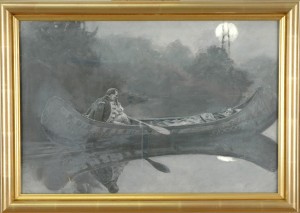
Howard Pyle (1853-1911)|My hatred of him seemed suddenly to have taken to itself wings’|Illustration for Harold Frederic’s “In the Valley” in Scribner’s Magazine v.8 (July 1890): 93 and in Harold Frederic, In the Valley (New York: Scribner’s, 1890) and in F. Hopkinson Smith, American Illustrations (New York: Scribner’s, 1892)|Oil on canvas|Norman Rockwell Museum, gift of Lila Berle, NRM.2000.04
In the prime of his artistic career, Howard Pyle was commissioned to create a series of twenty illustrations to accompany the serial publication of Harold Frederic’s (1856-1898) historical novel “In the Valley” for Scribner’s Magazine. The story chronicles political events in the Mohawk Valley from 1757 until 1780, during the Revolutionary War as the French, English, Indians, and colonists contend for control of the land. Born in Utica, New York, Frederic’s familiarity with the land and its history was an anchoring aspect in his life, even though by 1884 he was living in London as a correspondent for the New York Times.
Frederic’s story is told as reminiscence by an older man of the events that took place beginning in 1757, when he was eight years old. The protagonist and narrator of the story is Douw Mauverensen, who is of Dutch descent but due to the loss of his own father as a very young child, was adopted by an unmarried Scottish colonist. The pivot of the story is the contentious relationship between Douw and his contemporary Philip Cross, whose fathers had been friends and compatriots in Scotland. The enmity between the two boys is so great that their personal battle colors their adult lives and their politics. During the course of the war Douw Mauverensen has risen to be a major in the American army.
‘My hatred of him . . . ‘ is the last illustration of Frederic’s story and provides a visual conclusion that matches the written one of the story. This image was used near the end of the story in which Douw brings the mortally wounded Philip Cross back to Cross’s home in the valley and to Cross’s wife. This illustration shows Major Mauverensen resting his paddle seated in the stern of a birch bark canoe. The redcoat Cross lays in the bow slowly slipping away from life. At the end of the same chapter in which the illustration appears, Frederic wrote of their trip down the river toward home, “Every noiseless stroke of my paddle in the water, bearing him toward home as it did, seemed to push me farther back into a chill, unknown world of gloom and desolation.” Pyle skillfully creates the conflicting sense of peace, gloom, and even desolation through his use of blue and gray tones in this painting.
Pyle, like other illustrators, regularly painted illustrations that were to be transferred into wood engravings in grisaille—tones of gray, black, and white. For this painting he chose to add a bluish tone to his palette, which helped to convey the gloom of the night voyage, even though the coloration would not come into play in the wood engraved image. He also structured his picture so that the dying figure of Philip Cross is slightly lighter in tone that that of Douw Mauverensen. He further emphasized the calm spirit-like character of the dying figure by placing the moon in the sky and its reflection in the calm water below Cross’s face. In notes the illustrator W. H. D. Koerner took while a student in Pyle’s illustration class, he quotes Pyle as saying, “One way to get a spiritual feeling in a certain figure
Pyle must have felt pleased with the completed illustration. In 1892 it was chosen to be published in F. Hopkinson Smith’s American Illustrations, an overview of the best illustration recently created. And in 1898 Pyle sent it to Omaha, Nebraska to be displayed at the Trans-Mississippi and International Exposition.
[1] Howard Pyle Manuscript Collection, Box 3, Helen Farr Sloan Library, Delaware Art MuseumJuly 16, 2009
Joyce K. Schiller, Curator, Rockwell Center for American Visual Studies
Norman Rockwell Museum






